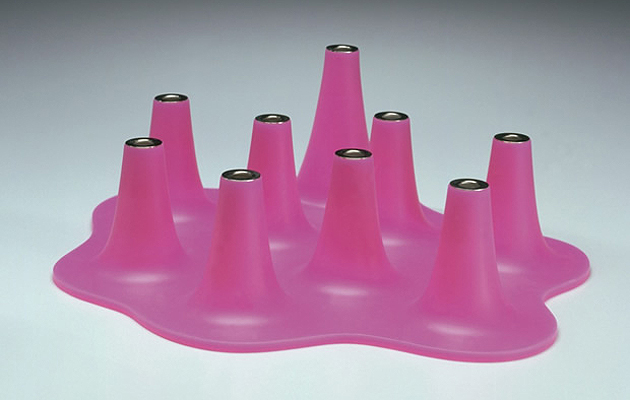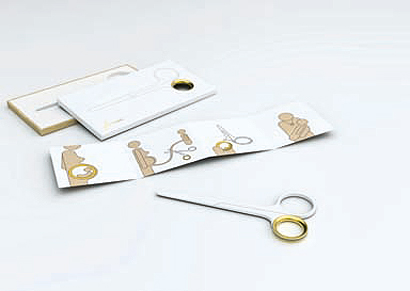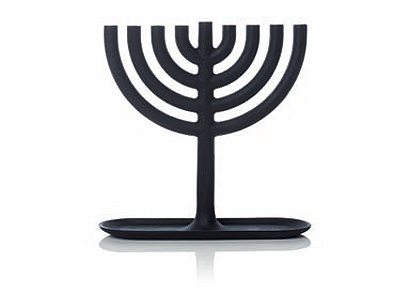|
|
||
|
Attempts to reimagine objects at the centre of rituals have proliferated in recent years, as designers seek to restore meaning to age-old habits and symbolism to significant but fleeting moments. Are such items bridging the gap between tradition and modernity or merely commodifying faith? When Karim Rashid made an amoeba-like Hanukkah lamp in hot pink silicone for the centennial of the New York Jewish Museum in 2004, it didn’t go down too well with the design or religious communities. “I’m not even Jewish and I’m offended,” wrote a commenter on one popular interiors website. Others complained that the random arrangement of Rashid’s radical Menorahmorph messed with the order of lighting the nine-branched candelabrum, which should be done from left to right – one candle for each of the eight days of the holy Jewish festival. But then, an unexpected thing happened. Menorahmorph became a cult object and a bestseller in the Jewish Museum shop. Editions were made in acid green, neon blue and bright orange. Today you can buy it on Amazon for $50. Those early detractors went back to the scrolls to debate the origins of the Hanukkah ritual, finding that some sects of Judaism disagreed with others on exactly how the lamp should be lit. Whether you were a fan of Rashid’s style or not, his ultra-modern menorah was a bold challenge to tradition, offering an alternative interpretation of the ritual object. It asked what contemporary designers could bring to the formulaic, repetitive and largely untouched world of ritual and opened up a new site of investigation for artists and designers concerned not just with religion, but politics, society and identity, too.
credit Studio Armadillo “There’s a lot of interesting dynamism that’s occurred since the museum started exploring this terrain in 2001,” says Daniel Belasco, curator of Reinventing Ritual, an exhibition at the museum in 2009. “I feel like it’s connected to a lot of other practices in art and design, and certainly well beyond Jewish practice in particular.” The exhibition brought together a mix of critical objects, including Studio Armadillo’s Hevruta-Mituta (2007), a chessboard of 32 knitted skullcaps. The design was a play on the traditional Jewish educational system of studying in pairs. “Each student takes a side in a debate. By challenging each other, they’re hopefully improving their understanding of the issues,” Belasco explains. “It’s a bit of an intellectual game, really. And chess, of course, is a secular version of it.” Belasco says that Reinventing Ritual’s provocations highlighted the divide between modern art and religion: “What surprised me is the great scepticism that a lot of religious people have about art. It’s not just that art despises religion, but religion thinks that art is useless. To perform a lot of these rituals, you don’t need anything fancy – just a cup and a candlestick. We tried to overcome that by showing that ritual isn’t purely mindless repetition, it can be an act of creativity.” On a commercial level, the exhibition was influential in reviving interest in Jewish ritual objects as pieces of mainstream industrial design. US-based retailers Areaware and Design Within Reach, both came out with their own menorahs in 2010 and 2011, respectively. In November 2010, Italian design house Alessi launched a range of objects specifically for practising Jewish rituals in the home. “So much of Judaism is a domestic religion,” Belasco says. “These really are treasured objects that are always on view, even when they are not being used.” With the days of the church, synagogue or temple acting as a patron of the arts long gone, it seems industrial designers rather than artisans, are stepping in to provide those who do practise religion with the kind of designs that fit with contemporary homes and lifestyles.
credit Sebastian Bergne Ltd Last year, designer Sebastian Bergne launched Colour Nativity, a set of wooden blocks whose mass, colour and composition alluded to the figures of the Christmas nativity in an abstract way. “Christmas is one of those stories that’s part of our culture,” Bergne says. “It’s such a commonly recognised moment. We’ve seen so many images of it – that’s what makes certain characteristics of it easy to abstract.” The product has been popular. After launching an initial limited edition of six, which quickly sold out, Bergne received weekly requests to make more and will produce an edition of 500 sets for 2012. Colour Nativity’s success lies in appealing to the familiar. It evokes childhood memories of assembling the nativity scene, preparing the house for Christmas – it’s a piece of nostalgia wrapped in a designerly aesthetic that even the most dedicated minimalist wouldn’t mind owning. “It’s not overtly Christmassy, and I like that,” he says. “Although Christmas is the only time you’re allowed to have bad taste, there’s definitely room for new interpretations of things – things that fit more with the way we live in terms of physicality, but also in terms of meaning.” Meaning, it could be argued, is what elevates ritual from routine. And Bergne’s London studio is full of the kind of curious objects that do just that. Monthly Measure (2011) is a kind of basic calendar made for French brand Atelier d’Exercises – a wooden rule with a jagged edge is marked with numbers and a die-cast star with a point for each day of the week is pushed along it to give the day of the month. “It’s a very satisfying thing to do,” Bergne says. “And very quickly you get into the ritual of doing it every morning.” In a mobile phone-reliant age, when people hardly wear watches any more, the calendar has been surprisingly popular. “It’s a reaction against the virtual and the not-real. It’s about doing something for pleasure rather than convenience. Increasing the necessary interaction with an object is what makes it ritualistic, in a sense.” And there are others who have found ritual objects, whether secular or religious, to be rich ground for exploration. BERG’s Matt Jones shared a prototype for his Shipping Forecast Rosary in Icon 088 – soothed by the sounds of the nightly BBC weather forecast, Jones mapped the shipping areas in wooden pieces and strung them together, turning his personal ritual into a physical object. In Rome last month, Italian designer Giulio Iacchetti exhibited Cruciale, an exploration of the universal symbolism of the cross in industrial design, rendering the cruciform in everyday materials and transposing it on to common objects such as house keys and notebooks. In New York, emerging designers Fredericks & Mae made Greek worry beads – or kombolói – part of their 2012 collection, re-imagining them in the materials of a fashion accessory: wood, leather, coloured thread and horsehair. In 2010, for one of its exploratory Designs On series, global consultancy IDEO took the ritual object one step further. Attempting to invent new rituals, the brochure asked if the moments we all share, like childbirth, could be made more ceremonious by the introduction of new objects. Nicholas Zambetti contributed the idea Light of My Life, a triangular arrangement of candles that would be given to a child and kept through adulthood, with one candle being lit every year.
credit Nicholas Zurchner/IDEO Designs on Birth Elger Oberwelz’s concept was the Forever Ring; a pair of scissors for cutting the umbilical cord that could later be worn around the neck. “Some cultures have rituals around the act of cutting the cord,” she says. “But in many cases this moment of significant psychological relevance is cut short due to the sterile hospital environment. My goal was to make the moment more memorable. Ritual objects are the enablers that can help us connect with these important experiences again.” And the future for ritual objects? As with most things, it’s likely to be interactive. In 2005 Turkish designer and Central Saint Martins graduate Soner Ozenc was already tinkering with tradition and technology with Sajjadah 1426, an electroluminescent prayer mat that helps Muslims find Mecca by lighting up when it’s pointed in the right direction. And last year, at MoMA’s Talk to Me exhibition, Interaction Research Studio, based at Goldsmiths, University of London, contributed the Prayer Companion, an aid for nuns at St Joseph’s monastery in York, that emerged from research on how the lives of older people can be enabled by technology. The device streams RSS feeds of news headlines and random bits of text taken from social media containing the words “I” and “feel” – giving the nuns a stimulus to pray in response to. “The notion was to give a feel for what people care about, both in the large newsworthy sense and the small, intimate scale,” says Bill Gaver, the professor at Goldsmiths who led the project. “The nuns withdraw to the monastery to avoid distraction, to be closer to God. They made it very clear that we shouldn’t design something distracting or inappropriate. So the challenge was to bring these technologies into a traditional world in a way that wasn’t whizzy or flashy.” Whether commercial, conceptual or research-driven, design that embraces religion can be a tricky thing to get right. Critics may argue that the process is turning faith into a commodity. Or that design should be left as a cult in itself. And, as with all new territories, Rashid’s menorah has paved the way for designs both bad and good. But for all the products that mindlessly toss the word “ritual” into their PR rhetoric in an attempt to add meaning, there is a wealth of objects that are genuinely poetic, thought-provoking and useful. Those objects show that there is a place for the designer in the effort to mix ancient traditions with contemporary attitudes. As Gaver says: “There’s nothing inherently contradictory about the new and old worlds. It’s just a matter of how you handle the medium.”
credit Josh Owen for Areaware |
Words Riya Patel
Image: |
|
|
||
























